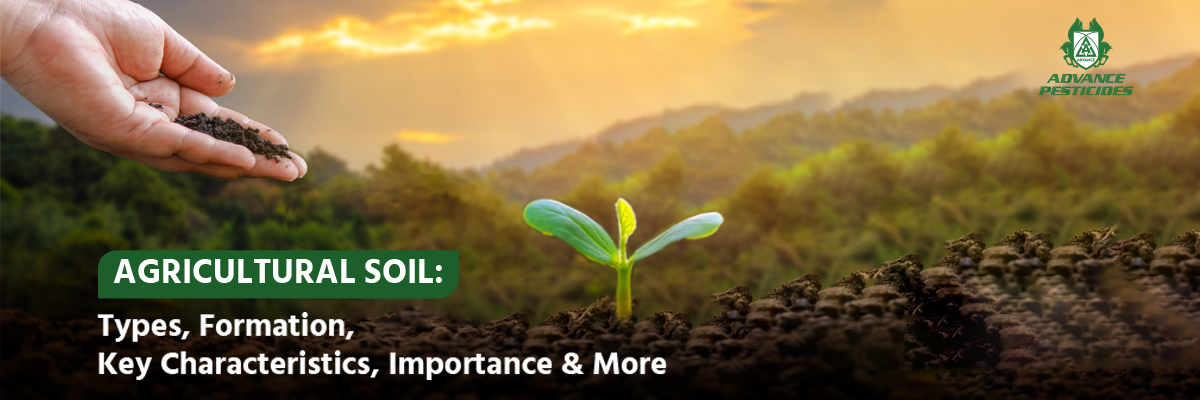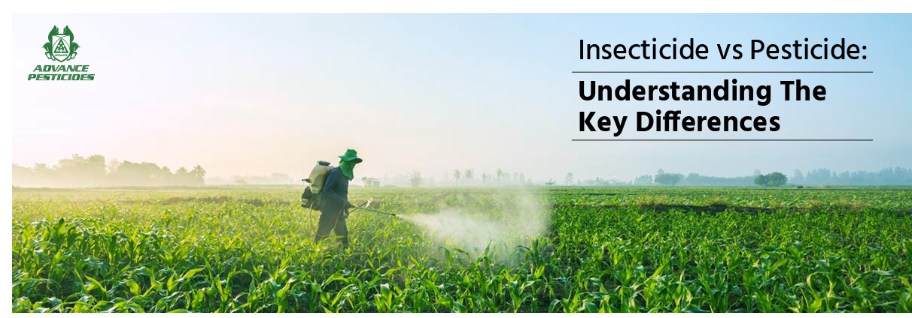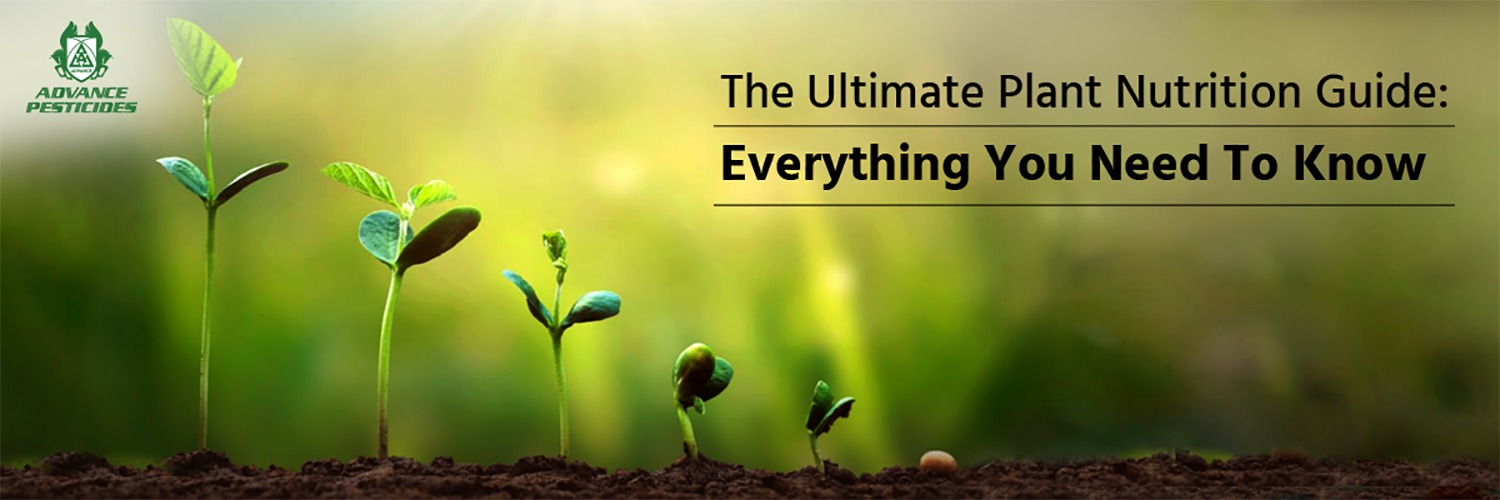Agricultural Soil: Types, Formation, Key Characteristics, Importance & More

What is
Agricultural Soil?
The top layer of the earth’s crust consists of
agricultural soil. Agriculture Soil is ideal for farming and agriculture for
its loaminess and fertility. Soil comes in many varieties and textures, but
only a few are suitable for agricultural practices.
Agricultural Soil Science is a branch of
science that deals with studies and the conditions of food and fibre
production. Soil is frequently regarded as the very backbone of agriculture,
and it is extremely valuable given the time it takes to exist properly,
allowing us to plant and produce various crops with higher yields and plant
quality.
Importance Of Soil In
Agriculture
The importance of soil in agriculture cannot be overstated. Soil serves as the foundation for plant growth and is critical in sustaining agricultural productivity. It provides plants essential nutrients, water, and physical support while serving as a habitat for beneficial microorganisms. Here are some key points highlighting the significance of soil in agriculture:
● Nutrient availability: Soil is a reservoir and source of essential nutrients, like nitrogen,
phosphorus, and potassium, vital for plant growth.
● Water retention and drainage: Soil can retain water, allowing plants to access it during dry
periods. It also facilitates proper drainage, preventing waterlogging and
ensuring sufficient oxygen supply to the plant roots.
● Physical support: The structure and composition of soil provide physical support to
plant roots, allowing them to anchor securely and absorb water and nutrients
efficiently.
● Microorganisms: Microbes in soil are essential in nutrient cycling, the decomposition
of organic matter, and the suppression of plant diseases.
Formation of Agricultural Soil
The formation of the agricultural soil is a
complex process. It takes thousands of years for soil to form. It results from
geological, biological, and climatic phenomena acting together. Given below are
the steps for the formation of agricultural soil.
Step 1: Weathering - Rocks undergo physical, chemical, and biological processes that break them down into smaller particles.
Step 2: Mixing with Organic Debris - The
weathered rock material mixes with organic debris, such as decayed plants,
contributing to the formation of agricultural soil.
Step 3: Chemical Alteration - Water seeping
through the weathered rock material causes slow chemical alterations, further
transforming it into agricultural soil.
Step 4: Time - The formation of just 1cm of
soil takes over 500 years, highlighting the gradual nature of soil formation.
Step 5: Biotic and Abiotic Components - Agricultural soil consists of a mixture of minerals, worms, decaying organic matter, humus, microorganisms, water, and air. All these matters contribute to the soil’s fertility and suitability for agriculture.
Soil Properties and Testing
Understanding soil properties and conducting
soil testing helps farmers and agricultural experts make informed decisions
regarding soil management and crop selection. Here are some key points related
to soil properties and testing.
Soil Texture, Structure, and Porosity
Soil texture refers to the relative proportions of sand, silt, and clay particles in the soil. It influences the soil's water-holding capacity, drainage, and aeration. Soil structure refers to how the particles are arranged and aggregated, affecting root penetration and nutrient movement. Porosity refers to the presence of open spaces or pores in the soil, which contribute to water retention and air circulation.
Soil pH and Nutrient Availability
Soil pH is a measure of soil’s acidity or
alkalinity and plays a crucial role in nutrient availability. Soil pH affects
the solubility and accessibility of essential nutrients.
Soil Testing Methods and Interpretation
The most common method to assess soil
nutrients is through chemical soil testing. Soil tests primarily report on the
levels of nitrogen (N), phosphorus (P), and potassium (K), which are essential
for crop growth. Secondary nutrients like calcium (Ca), sulfur (S), and
magnesium (Mg) are also examined. Additional tests may include minor elements
like iron (Fe), manganese (Mn), boron (B), and molybdenum (Mo), among others.
Types of Soil for Agriculture
The type of soil plays a significant role in
determining its suitability for different crops and agricultural practices.
Some common types of soil found in agricultural settings are described below.
Sandy Soil
Sandy soil has larger particles and drains quickly. It has a low water-holding capacity and is prone to leaching, making it less suitable for retaining nutrients. However, it warms up quickly in spring and is suitable for early planting.
Clay Soil
Clay soil has a compact structure, and it can
hold sufficient moisture. It is suitable for plants that require moisture for
growth.
Loamy Soil
It has a balanced combination of organic
matter, which makes it the most important soil for agriculture. The soil allows
good drainage, root penetration and aeration.
Silt Soil
Silt soil has medium-sized particles, smaller
than sand but larger than clay. It has good water-holding capacity but can be
easily compacted. Silt soil benefits from organic matter additions to improve
its structure and fertility.
Peat Soil
This soil consists of partially decomposed
organic matter and is rich in nutrients. It has a high water-holding capacity
but can be acidic and compacted.
Chalky Soil
A soil characterised by a high content of
calcium carbonate and is typically alkaline is referred to as chalky soil. It
can have poor water retention and drainage, as well as limited nutrient
availability. Chalky soil often requires organic matter additions and specific
crops.
Soil Conservation Practices
Soil conservation aims to protect and enhance
soil health using diverse approaches and strategies. Individuals dedicated to
this cause strive to maintain soil fertility and productivity and shield it
from erosion and degradation. By prioritising the well-being of the soil, we
can uphold its essential roles and ensure a sustainable environment for the
future.
- Conservation tillage: Minimises ploughing intensity and preserves crop residue to
conserve soil, water, and energy resources, benefiting nutrient cycling
and water conservation.
- Contour farming: Furrowing the land with contour lines reduces runoff, maintains
a steady altitude, and improves soil retention, enhancing crop yields.
- Strip cropping: Alternating strips of closely planted crops with row crops on
slopes to prevent erosion. This creates natural dams for water, preserving
soil fertility.
- Windbreaks: Planting rows of dense trees between crops to reduce soil
erosion in flat farming settings, acting as a barrier against wind and
preserving soil strength.
- Crop rotation: Cultivating various crops in the same location over time to
combat soil infertility, manage nutrient requirements, and reduce reliance
on a single nutrient source.
- Cover crops: Growing non-commercial crops to protect the soil during fallow
periods, mobilise and recycle nutrients, improve soil structure, control
pests and weeds, and reduce erosion.
- Buffer strips: Permanently vegetated zones between water bodies and farmland,
aiding in soil retention and slowing and filtering storm flow. This also
minimises the entry of harmful substances into lakes or water sources.
Soil Amendments and Fertilisers
Soil amendments are any materials that are
mixed into topsoil to encourage healthy plant growth. They work in many ways,
like they can alter the pH of the soil or provide nutrients. Fertilisers are
valued primarily for their ability to provide nutrients. Plants use these
nutrients to produce plant growth components such as proteins and
carbohydrates.
Organic and inorganic soil amendments
Soil amendments are classified into two types: organic and inorganic. Organic amendments are derived from living organisms. Inorganic amendments, on the other hand, are either mined or created artificially. Sphagnum peat, wood chips, grass clippings, straw, compost, manure, biosolids, sawdust, and wood ash are examples of organic amendments. Vermiculite, perlite, tyre chunks, pea gravel and sand, are examples of inorganic amendments
Fertiliser types and application methods
Fertilisers are classified based on their
nutrient content, which is typically labelled with three numbers representing
the percentage of nitrogen (N), phosphorus (P), and potassium (K) they contain.
Fertilisers are classified as synthetic or organic. Synthetic fertilisers are
manufactured and provide nutrients in readily available forms, whereas organic
fertilisers are derived from natural sources and release nutrients gradually
over time.
Balancing soil nutrients for optimal plant growth
Balancing soil nutrients, including
macronutrients (nitrogen, phosphorus, potassium) and micronutrients (iron,
zinc, manganese, etc.), is crucial for promoting optimal plant growth, yield,
and overall crop health.
Which Soil is Suitable for Agriculture?
Loamy-textured soils are commonly described as
medium textured, with functionally equal contributions of sand, silt, and clay.
These medium-textured soils are frequently regarded as ideal for agriculture
because they are easily cultivated by farmers and can be highly productive for
crop growth.
Key Characteristics of Agricultural Soil
Agricultural soil possesses key
characteristics that are vital for supporting plant growth, nutrient
availability, and overall agricultural productivity. Understanding these
characteristics helps farmers make informed decisions about soil management and
optimise their farming practices.
The key characteristics of agricultural soil include:
●
Optimal water-holding capacity
●
Good aeration
●
Fertility and friability
●
Suitable pH level
●
Good texture and consistency
●
Abundance of nutrients
Challenges and Future of Agricultural Soil
Agricultural soil faces numerous challenges
that can impact its quality and productivity. One major challenge is soil
degradation, which occurs due to factors like erosion, nutrient depletion, and
pollution.
Another challenge is the loss of soil biodiversity. Healthy soil contains a diverse array of microorganisms, fungi, and insects that contribute to nutrient cycling, organic matter decomposition, and pest control.
To solve these problems and ensure the future of agricultural soil, conservation is important. Conservation techniques like crop rotation, cover cropping, and contour ploughing help prevent soil erosion and maintain soil structure.
Conclusion
Agricultural soil often faces degradation,
biodiversity loss, and pollution. To maintain the quality of agricultural soil, it is important to
conserve soil quality and promote biodiversity. Soil health and productivity
can be protected by minimising environmental pollution. It can be done by using
the processes like crop rotation, cover cropping, and precision agriculture.
Soil management research and education solve these problems and ensure a
sustainable agricultural system.
FAQs about Agricultural Soil
Q1.
What is the difference between forest soil and agricultural soil?
Forest soil is rich in nutrients as it
contains a very thick layer of organic matter. Whereas, agricultural soil
contains less organic matter because of the intensive cultivation process. The
soil requires frequent nutrient input to maintain its fertility.
Q2. What is soil profile in agriculture?
A soil profile is a vertical cross-section of
the soil made up of layers that run parallel to the surface.
Q3. What is soil pH, and why is it important in agriculture?
The acidity and alkalinity of the soil are
measured by soil pH. Agriculture places a great deal of emphasis on the soil pH
because it regulates plant nutrient availability by regulating the chemical
forms of the various nutrients and also affects their chemical reactions.
Q4. How to do a soil test for agriculture?
The first step in developing a sound nutrient
management programme is to determine the pH and fertility level of the soil
through a soil test. Soil samples from soilless mixes are tested differently
than samples from field soil. There are three commonly used methods for testing
soilless media using water as an extracting solution: the 1:2 dilution method,
saturated media extract (SME), and leachate Pour Thru.
Q5. Which soil is suitable for agriculture in India?
Alluvial soil is suitable for agriculture in India.
Q6. What is the importance of soil testing in agriculture?
A soil test is essential for various reasons,
including
●
Optimising crop production.
●
Protecting the environment from
contamination caused by runoff and leaching of excess fertiliser.
●
Assisting in the diagnosis of
plant culture problems
●
Improving the nutritional balance
of the growing media
Take Control Of Your Crop's Health with Advance Pesticides
At Advance Pesticides, we offer a wide range
of high-quality products to help you take control of your crop's health. Our
advanced pesticides are designed to effectively manage pests and diseases,
ensuring the optimal growth and yield of your crops. With our expertise and
innovative solutions, you can trust us to provide the necessary tools for a
successful and thriving agricultural operation. Visit AdvancePesticides.com today to discover
how our products can benefit your crops and maximise your agricultural
productivity.





